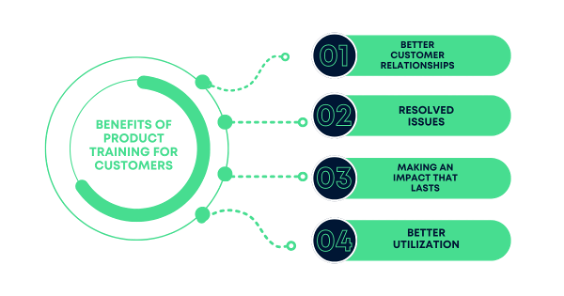6 Reasons to Adopt Product Training for Customers!
Let's see why you should adopt product training for your customers
Hey there!
Thursday calls for an exclusive and brain-storming bulletin from Acadle! So, here I am, bringing you a fresh topic for this week. So, let’s cut to the chase and see why you should adopt product training for your customers.
Every business requires two primary things: happy customers and savings on miscellaneous costs. And what if I told you that customer-product training helps in achieving both?
What is product training for customers?
Product training for customers establishes the best methods for educating consumers to use and understand the product more effectively. It enables firms to understand how to extract the most value from the goods or services you offer them.
We frequently mistakenly believe that customer product training is just intended to speed up onboarding. However, numerous advantages of product training include cost savings, simplification of processes, and increased client pleasure.
5 ways customer product training benefits your customers
1. Better customer relationships:
Building strong customer relationships is aided by ideal customer product training. Before making a decision, customers need to have confidence in both the product and the salesman. If the customer is not informed about the product or service you are offering, he or she will begin to have doubts about the product. Therefore, you will be able to impart the proper product knowledge to your consumers and improve customer retention with the right customer product training.
2. Resolved issues:
Your customers can get answers to their questions without having to wait for customer service. By educating your customers beforehand about your goods or services, you can handle problems more promptly. With the assistance of pre-built training courses, they can quickly and conveniently access the resources whenever they want.
3. Making an impact that lasts:
There is a lot of competition, so if you want your firm to succeed, you must stand apart. Furthermore, you can leave a lasting impression on your clients by using customer training programs that are effective. They will be educated in advance in all the characteristics and capabilities, preventing them from rushing to the rivals to learn more and comprehend the product.
4. Better utilization:
To know what you can gain from a product, it is important that you first understand it. With the appropriate product knowledge, the customers will be able to analyze their needs and also demand more features and services.
6 Reasons to adopt product training for customers:
1. Increased Sales: You will be able to create positive connections with your clients. Additionally, because they will be able to use your product or service to its fullest capacity with this knowledge, your sales will increase.
2. High levels of customer satisfaction: The client will be pleased with all the benefits he can derive from your goods or services.
3. Increased client loyalty: Higher levels of customer satisfaction and retention will result in more loyal customers.
4. Growth in product adoption: Even if you sell the most popular LMS in the world, it won't be useful if your clients don't know how to use it. Your customers will be able to quickly accept the product with the proper product training.
1. Build trust: Customers will be able to trust your brand if you have an efficient and suitable training program.
2. Save costs: Send less money on one-on-one customer support because your company will incur less expense as a result of more customer training. You can lower the number of questions consumers have and cut costs by providing good customer training.
Steps for a relevant product training program?
We now understand how product training can enhance both your business and your customers' understanding of the project. However, you may now be asking yourself, "How can I develop a successful product training program?" Let's check, then:
1. Always elicit pertinent information:
To create an engaging course, you must first ask yourself a number of questions before creating a training program for your clients.
What demographic do I want to reach?
What are the demands of my clients?
What is the customer lifecycle complexity?
2. Maintaining consistency in your training plans is crucial.
Make sure you regularly provide your consumers with useful information so they can follow training programs and better retain knowledge.
3. Have scalability:
Ensure the scalability of your training initiatives. Your business will be expanding continually, therefore it's critical to design scalable training programs that can be adjusted to meet changing needs.
Simple steps to build a product training program with LMS?
1. Decide who to address:
Creating an ideal trainee profile will help you create a better training program, so do that first and foremost.
2. Include the following in your training:
Choosing what needs to be included in your training program is the next stage. You must choose the content for the programs and how it will be distributed among the many modules.
· To help your clients retain information, incorporate gamification into your training programs. You can encourage people to finish the training program by giving them badges or awards.
· Make sure your training program is participatory for your audience as well. You can include scenario-based learning activities that let users engage with your material.
· You should also present diverse content to your audience. It should be a perfect mixture of videos, photos, infographics, or presentations. So, that your audience doesn't become lethargic about the same content being delivered daily.
3. Determine the courses' distribution:
The next step is to choose how you will deliver the courses to your audience. There are several options to consider:
· Asynchronous lessons: These are independent learning courses where your users set their own pace.
· Live courses: It comprises webinars or follow-up courses with quizzes.
Lastly, your learning management system can be used to measure the metrics. You can see how your learners are responding to your courses and the frequency of their course completion.
I genuinely hope that this edition was instructive and improved your understanding of product training for customers. We'd be interested in hearing your thoughts about our bulletin.
Drop your suggestions and feedback in the comment section below





